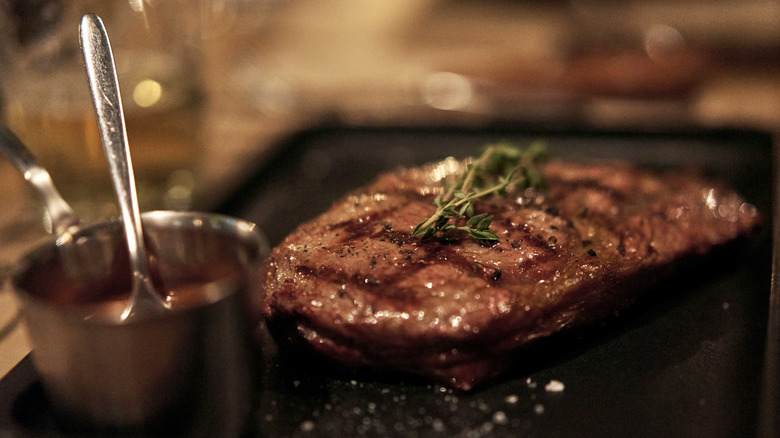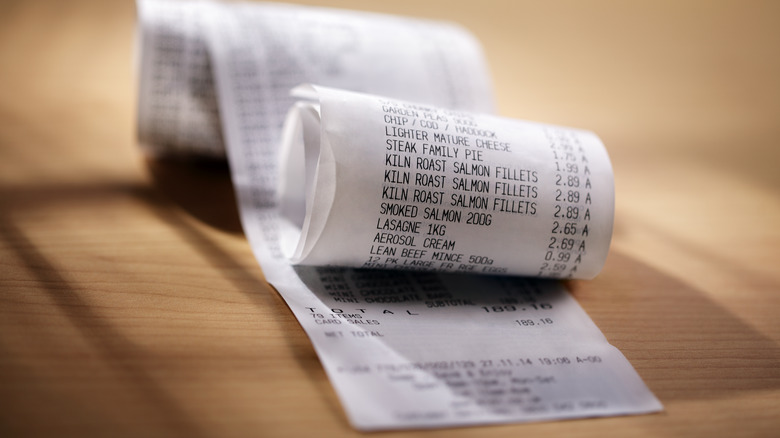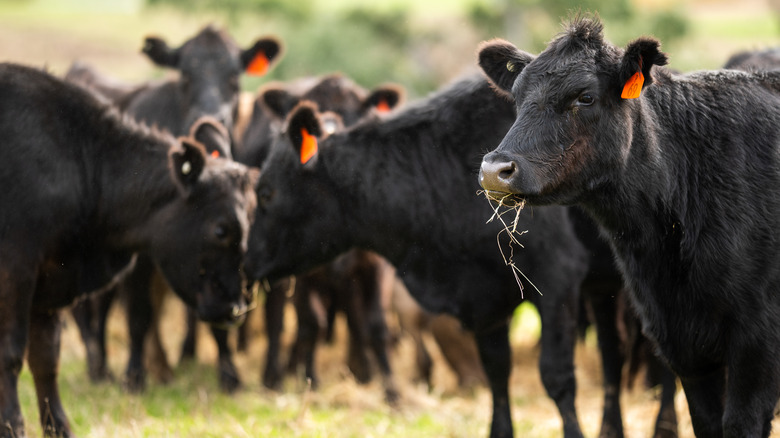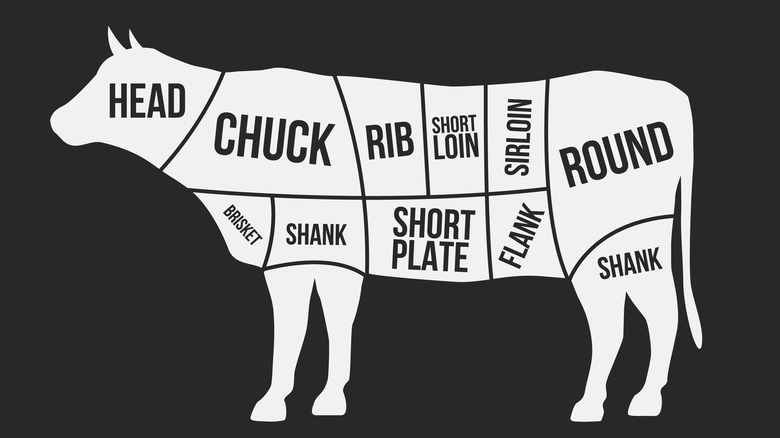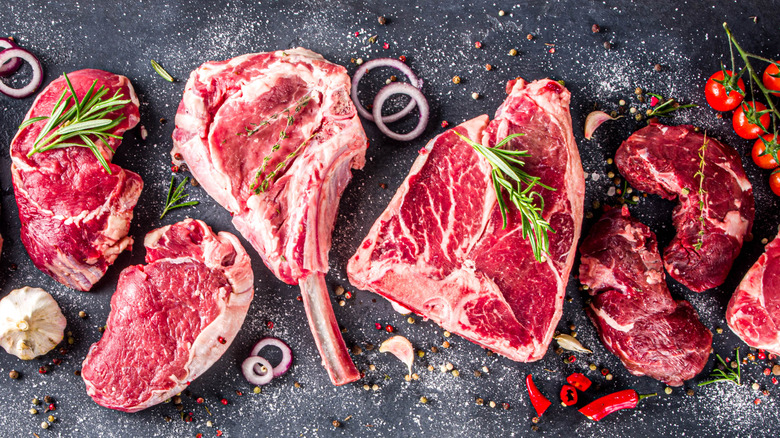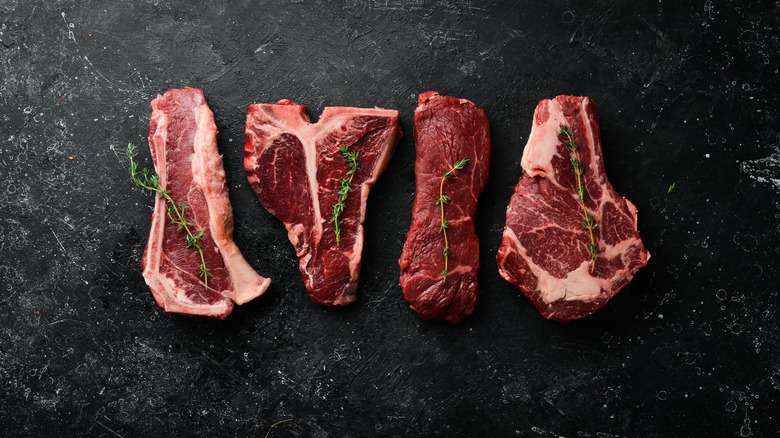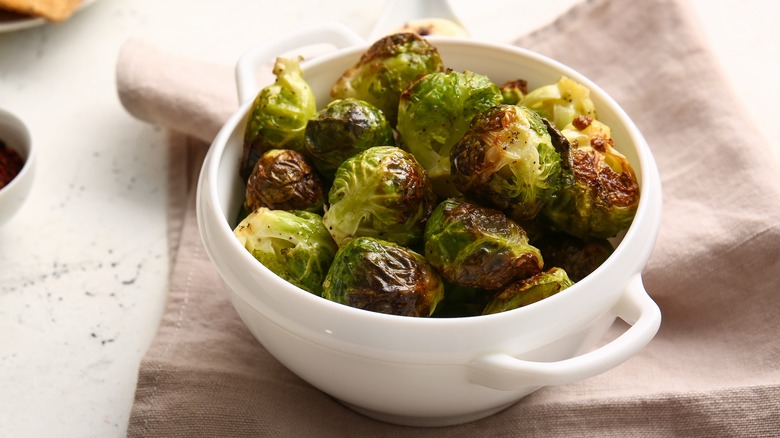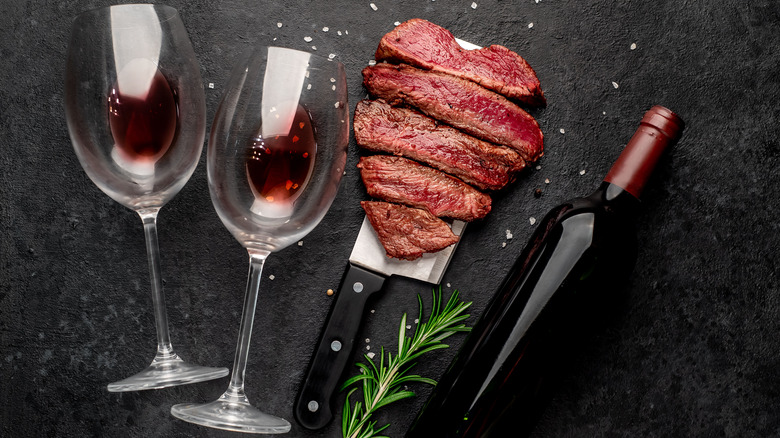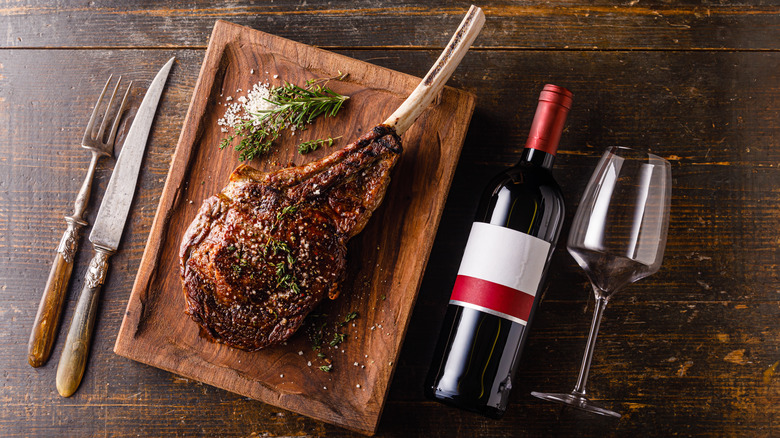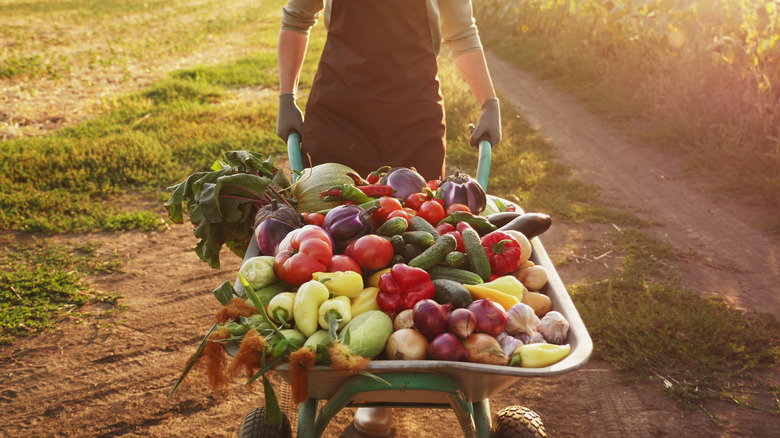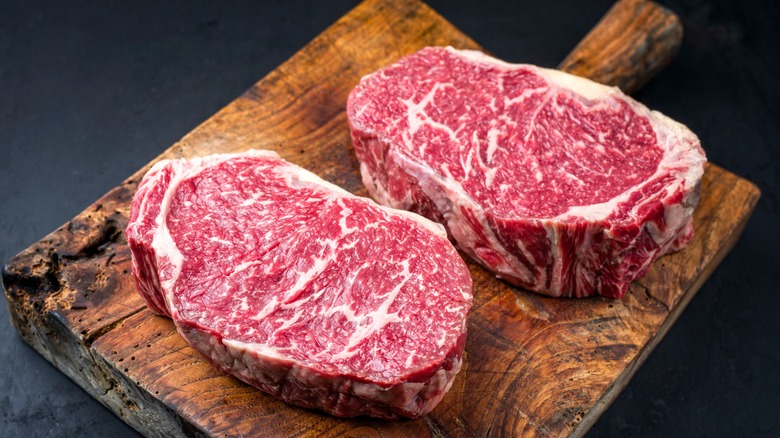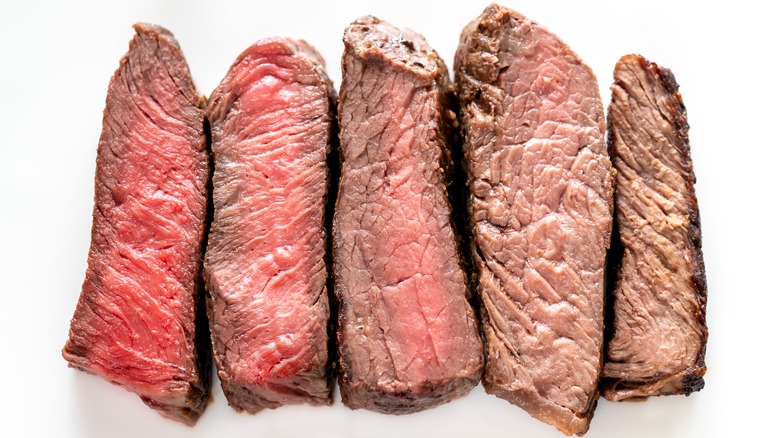How To Order At A Steakhouse Like You Know What You're Doing
Ordering from a steakhouse for the first time can be an intimidating experience, especially when the restaurant in question is decidedly closer to upscale than casual. Just about everyone can go to an Outback Steakhouse and dine with confidence, but not everyone is inherently comfortable going out to eateries with white tablecloths and steaks that can cost a fair amount more than the average grocery store slab of beef. But fear of the unknown should not be the reason anyone avoids the amazing experience of eating out at a proper steakhouse (where the quality of the meal is as rare to come across as the beef is rare to cut across).
But in order to eat at a steakhouse with confidence, you first need to know how to order at a steakhouse like you know what you're doing. After all, it wouldn't do to sit down to a menu that may as well be written in hieroglyphs for all the sense it makes. Sous-vide? A la mode? Bleu? Since when did you have to know French to order an all-American cut o' cattle?
Rather than worrying about what Wagyu's right for you, if you know the red flags at a steakhouse that should make you turn around, or whether or not you can hold your own ordering at the dinner table, just read through these tips to avoid any and all the most common mi-steaks people make at a steakhouse.
Choose the right place
The thing about going out to eat at a top-tier steakhouse is, if it's actually a top-tier steakhouse, every part of their dining experience, from A to Z, should be tailor-made to help promote customer comfort and an easy, enjoyable experience. In fact, even a first-time steakhouse customer who doesn't know the difference between a filet of fish and a beef flank should be made to feel confident making their choices for the meal at hand.
Truly excellent eateries (the kind you write home about) are that excellent because they've already streamlined the entire mealtime for you, which ultimately means that the most important tip for feeling like a steakhouse savant is choosing the right steakhouse in the first place.
Look ahead at the menu
If you're the kind of person who has trouble making in-the-moment decisions, know you're not alone — even the most seasoned steakhouse connoisseur spends some time perusing online menus beforehand. Knowledge is power, after all. Say you don't know a word — you can simply look it up! Wondering if regular versus prime beef is worth the cost? Ask the internet. Confused about a certain cut of beef? Well, you know what to do.
This small act of forethought can mitigate a million and one in-the-moment ordering off-the-menu disasters before they're so much as a twinkle in your server's eye. So, study the menu a bit before the big steakhouse test and you're sure to get an A (for Angus beef).
Beware of upcharges
Eating out at a steakhouse (even at your favorite chain steakhouse) can be a sizeable financial commitment, and well worth the money spent ... provided you avoid those pesky upcharges, of course. We've all been there: a drink or two in, appetizers well underway, and when it's time to order your main course you think, "Oh, what harm could a few add-ons be?" Then, one $20 loaded baked potato, $75 steak, and $15 compound butter (with truffle shavings for only $30 more) later, you get the check and realize that all those add-ons really added up.
And though almost everyone is capable of some basic addition, few can apply it in the heat of the moment at a tempting steakhouse. So, it's best to follow one golden rule and avoid upcharges at all costs.
Know your cows
Believe it or not, different breeds of cows have different qualities they bring to the table (so to speak). And a steakhouse is the perfect place to explore that difference. In the same way that milk from various kinds of cows can have different flavors and fat content, so too does the steak. Black Angus is a popular and well-known breed of meat cow that is served widely across the United States. Its flavor is valued for being rich, juicy, and tender from a decent amount of natural, well-dispersed fat marbling.
Another breed of beef cattle that is prized for the quality of its meat is Japanese Wagyu, known around the world for its unbelievably tender texture, terrific taste, and top-of-the-line marbling.
Know your cuts
Just like different kinds of cows are valued for their diverse range of qualities, so too are different parts of the cow. Though cut preference varies widely from culture to culture and, frankly, person to person, it can still prove useful to understand the essential bare-bones of the most quintessential steakhouse selections.
Just take a look at an easy guide to beef cuts and remember that the most tender cuts of cattle usually aren't the most flavorful. So, if you don't mind a bit of chew to your beef, consider selecting something other than a filet (which, while tender, is a little less flavorful). Some generally excellent steakhouse selections that you can always rely on are the ever-classic T-bone cut, the New York strip, and a ribeye.
Steak size matters
Not all steaks are made equal, and that rule pertains just as much to the size of a steak as it does to quality, cut, or any other characteristic. When it comes to ordering at a steakhouse like you're as good as Gordon Ramsay, there's nothing more important than ordering the correct portion size for yourself or your table. That means knowing how much you (and/or your companions) can eat and also knowing what to order to satisfy that.
The only thing worse than ordering too much meat and having to ask for a carryout bag for a prime porterhouse? Leaving a steakhouse hungry — that's what's worse. So, just make sure you can tell a petite cut from a 72-ounce all-you-can-eat challenge.
Bone-in vs. boneless
In the world of all things meat, there is an age-old debate that has yet to truly be settled: bone-in or bone-out? This pertains to chicken wings, pork chops, and, of course, cuts of cattle too. The crux of this culinary conundrum lies partly in the belief that bones add flavor and protect steak from becoming overcooked and dry. On the other hand, boneless steak is far easier to cook evenly and can be eaten without using your hands.
Because some believe bones are synonymous with flavor, they can't imagine going boneless. And others just like the lack of hassle that comes with a boneless cut. If you want the best of both worlds, simply ask your server if they can pre-slice your bone-in cut before serving it up. That way you can have your bone-in ribeye (and eat it too).
Don't forget the apps and sides
Ordering apps and sides that compliment your cut of beef is essential to having a good steakhouse experience. So, instead of getting caught off guard the next time a server asks what sides you want for your steak, which usually results in a rushed answer of soup, salad, or french fries, spend a moment really looking at the options available.
You may find yourself surprised at all the blackened Brussels sprouts, bacon-y green beans, twice-baked potatoes, mushroom gravies, compound butters, veggie medleys, and more that may have otherwise passed you by. In the same way that a perfectly cooked prime rib is best served with creamed spinach and horseradish, some steaks have natural pairings that you just can't compete with.
Defer to your server
One way to get a steakhouse meal that tastes like it's been ordered by someone who knows what they're doing is to, well, let someone who actually knows what they're doing order for you. That's right — deferring to the steakhouse staff is the secret trick for entry-level steak eaters to feast like seasoned kings. After all, these employees are professionals and, frankly, there's no shame in asking for their suggestions or for their guidance.
In fact, even people who eat out at a different steakhouse every Sunday should and do defer to their servers to hear about the freshest meat shipments, possible specials, personal recommendations, and more. There's a lot to learn from the person taking your order, a trick Anthony Bourdain knew well.
Wine and booze pairings
What better beverage is there to pair with a perfectly good steak than a perfectly pleasant drink, often a little (or a lottle) alcoholic? Any steakhouse worth its salt will offer a carefully crafted wine menu, which will hopefully be presented by a server who can suggest the best wine pairings for steak.
You can also reasonably expect to see other alcoholic beverages such as beer, cider, mead, hard kombucha, and the ever-classic cocktails that steakhouses do oh so well. If drinks are on the menu, then an excellent way to calm the nerves and start off the evening ordering strong is by getting a cocktail, any cocktail, and reveling in the simple fact that there's no wrong way to pair a pre-appetizer drink.
Skip the tomahawk
Yes, everyone loves a tomahawk steak — and on the surface, it makes complete sense. They're downright visually impressive clubs with a huge hunk of succulent meat that's been seared to perfection and served up still attached to a bone so weighty you probably couldn't get it past TSA at the airport. But that's just it, the bone makes up for most of the weight of a tomahawk, and steaks are (more often than not) sold by weight.
This means you're paying a whole lot extra just to see an inedible portion of rib at the end of your ribeye. Steakhouse savants know better than to give into tomahawk temptation, and now you can do the same. So, go with ribeye over tomahawk and buy yourself another drink to celebrate avoiding this common steakhouse mistake.
Look for locally sourced menus
Fresh is best, and the most fresh foods are those that haven't had to travel very far from the farm to your fork. This is easy to observe in seasonal vegetables, such as those sold at farmer's markets. But, just like fruits and veggies, meats and meat products can also be sourced from local farms and farmers.
Nothing adds credence or flavor quite like food that's been raised nearby, and seeing California cattle on a California menu is (generally) a good sign. That is unless the meat you want is Japanese Wagyu or another specialized import that simply doesn't come from someplace nearby. A steakhouse is no exception to the fresh is best concept, and it's a great green flag to know any eatery understands the importance of locally importing produce.
Be wise to Wagyu grades
Wagyu is one of those things that you've got to try at least once, and there's no better place to get that first taste than at a steakhouse. But before you rush off, know that there's more to ordering Wagyu than asking for a Wagyu steak done medium rare. In fact, there's an entire Wagyu grade scale you need to at least know about before you even attempt to order this particular prized beef.
Luckily, the Wagyu scale is as simple as knowing your A, B, and Cs and your 1, 2, 3s ...4s and 5s. In other words, Wagyu grade A is best, B is second best, and C is the least desirable (of the most desirable). In terms of numbers, 5 is best. So, an A-5 Wagyu steak is as good as it gets. The C-1 Wagyu cut, on the other hand, is on the low end of Wagyu, but is still Wagyu, and who would turn their nose up at Wagyu?
Don't order a prime cut well done
When it comes to ordering steak at a steakhouse, you don't have to get it bleu, rare, or even medium rare ... but asking for steakhouse beef done well is a bit much, especially if it's for a choice cut. Most steakhouse menus will include fully cooked alternatives such as slow-cooked cuts like brisket, ribs, and fork-tender stews.
Of course, everyone is entitled to their opinion, but there's a good reason that most professional chefs cringe at the idea of cooking a choice cut of beef past a certain temperature, and it isn't a simple matter of preference. No, it's because steaks can reach a point of negative return for texture, juiciness, flavor, fat content, and quality in general. In terms of ordering at a steakhouse like you know what you're doing, just order the chicken before you get steak well done.
Ask questions
There's no reason to avoid asking questions — after all, everyone has to start somewhere, and asking a server questions at a steakhouse is the best way to learn about ordering at a steakhouse. To put it bluntly, you'll never learn to order off a steakhouse menu like you know what you're doing if you're not willing to first order at a steakhouse without really knowing what you're doing.
Like most things in life, you can do everything you can to prepare yourself for something, but at a certain point, you have to take the jump. And, in this specific scenario, that leap of faith means going to a steakhouse, ordering as best you can, and (above all) being willing to ask a question if you don't know something. After all, you're at a steakhouse, and anyone who works there is employed for their ability to answer questions pertaining to steak.
Save room for dessert
There's no better way to properly put an end to a tasteful steakhouse dinner than by following it up with a delicious, post-steak dessert. Though the sweet treats on display may be limited in number, it doesn't do to underestimate steakhouse desserts.
There's no real predictable pattern as to what makes it to the post-dinner menu of a steakhouse and options can and will vary between more classic options such as cheesecake, bread pudding, pie, and chocolate lava cakes. The more high-scale the steakhouse, the more items like creme brulee and souffle you're likely to see. So, save room for dessert and dig into whatever sweet most appeals to you. And for those who aren't big on sweets, you can always order another drink instead.

